This post may contain affiliate links. Please read my disclosure policy.
You’ve been hearing a lot lately about the precautions you and your loved ones can and should take to keep healthy. Hand sanitizer, in particular, has never been more popular, since it’s been widely documented as one of the best ways to protect yourself on-the-go. I’ve never been a big fan of hand sanitizer (in theory, it kills both the good and the bad germs), but sometimes we gotta do what we gotta do! Nothing’s more important than keeping ourselves and the people we love healthy, right?
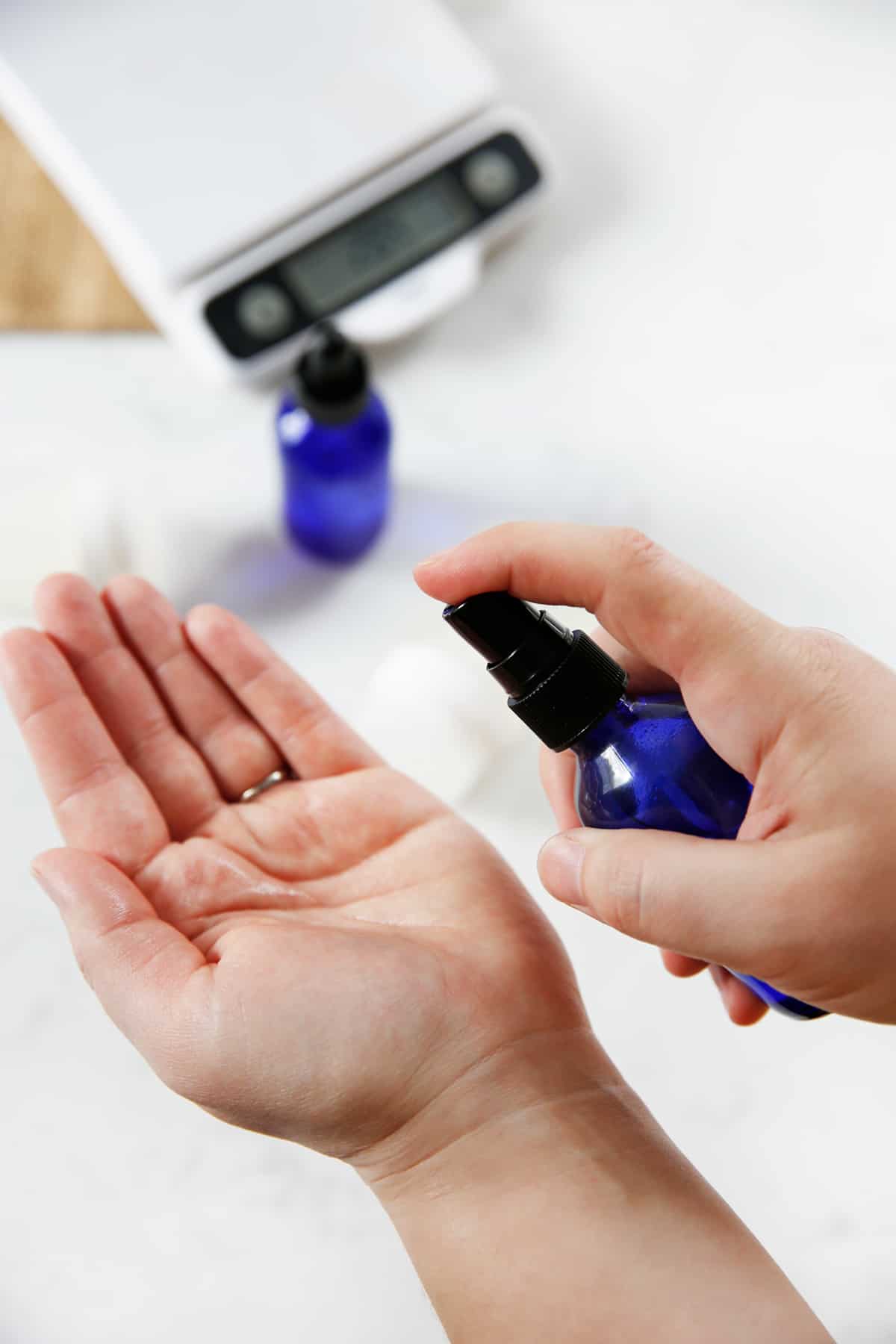
How to Make Your Own Hand Sanitizer
Before we go much further… I want to remind you that washing your hands in the sink with soap and water is still always, always, always going to be your best option. The Centers for Disease Control and Prevention (CDC) say so, and I’m all about trusting the experts! I also love my clean, safe hand soap from Beautycounter, which makes washing my hands an even nicer experience.
But let’s get real: you aren’t always going to have easy access to a sink and soap, and unfortunately, the moments when those things aren’t available can definitely be the same moments when you feel like you need them the most!
If you and your loved ones are out shopping, traveling, or doing other activities in public, you’re bound to feel like you need a quicker fix, especially during cold and flu season or the spread of more serious diseases like Covid-19. When you’re out and about, you shouldn’t wait until you get home to fight germs on your hands. If soap and water aren’t available, you should use a hand sanitizer that contains at least 60% alcohol.
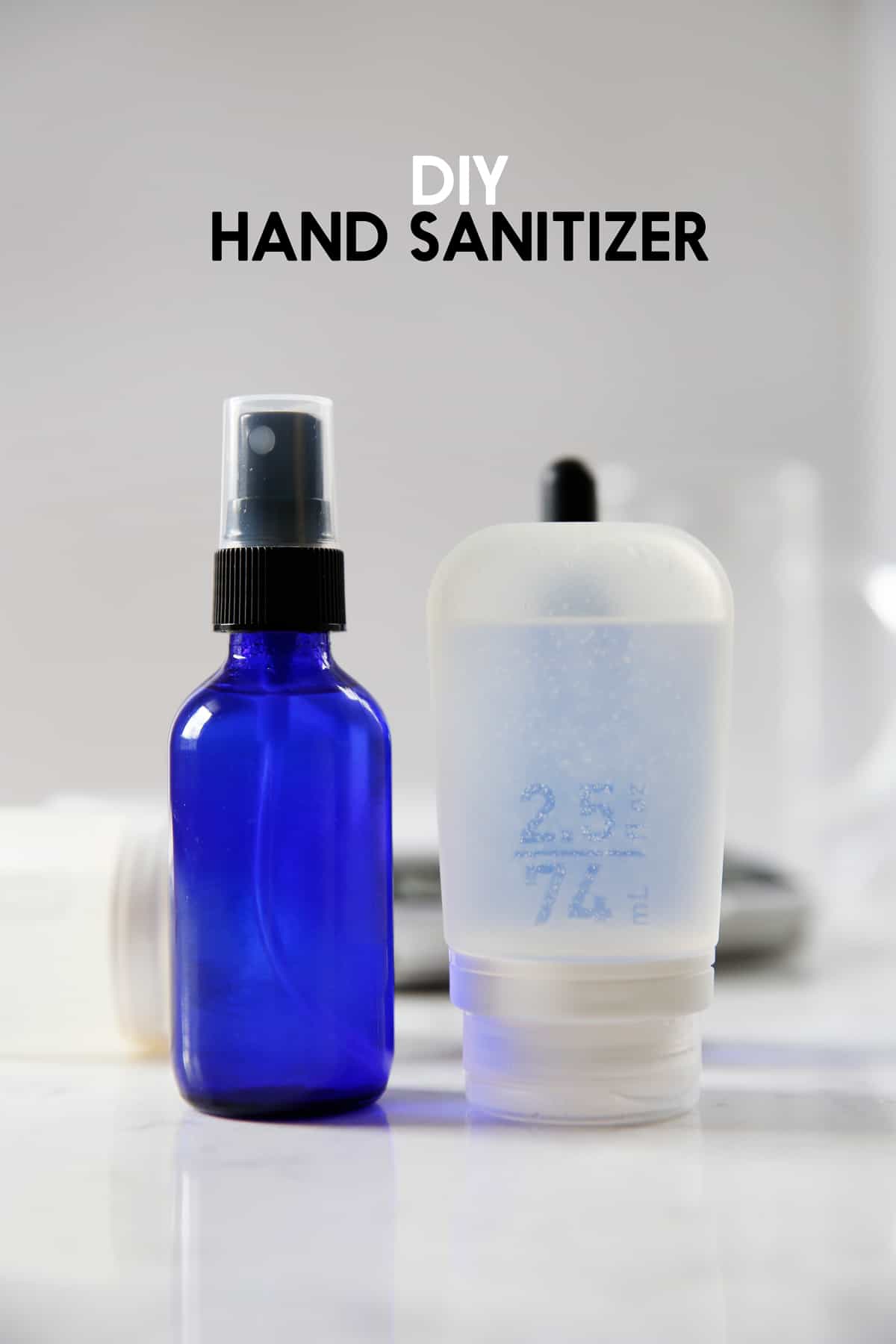
Hand sanitizer is a quick, convenient solution that’s easy to travel with and can reduce the number of microbes and germs on your hands, according to the CDC. Store-bought, scientifically-formulated hand sanitizers are a solid next option when you can’t wash your hands with soap and water.
If you’re having trouble tracking down hand sanitizer at the store, you can make your own. While this can work in a pinch, it’s still not as reliable as the store-bought kind, in which all of the chemicals are perfectly proportioned. So make sure you do your due diligence with measurements!
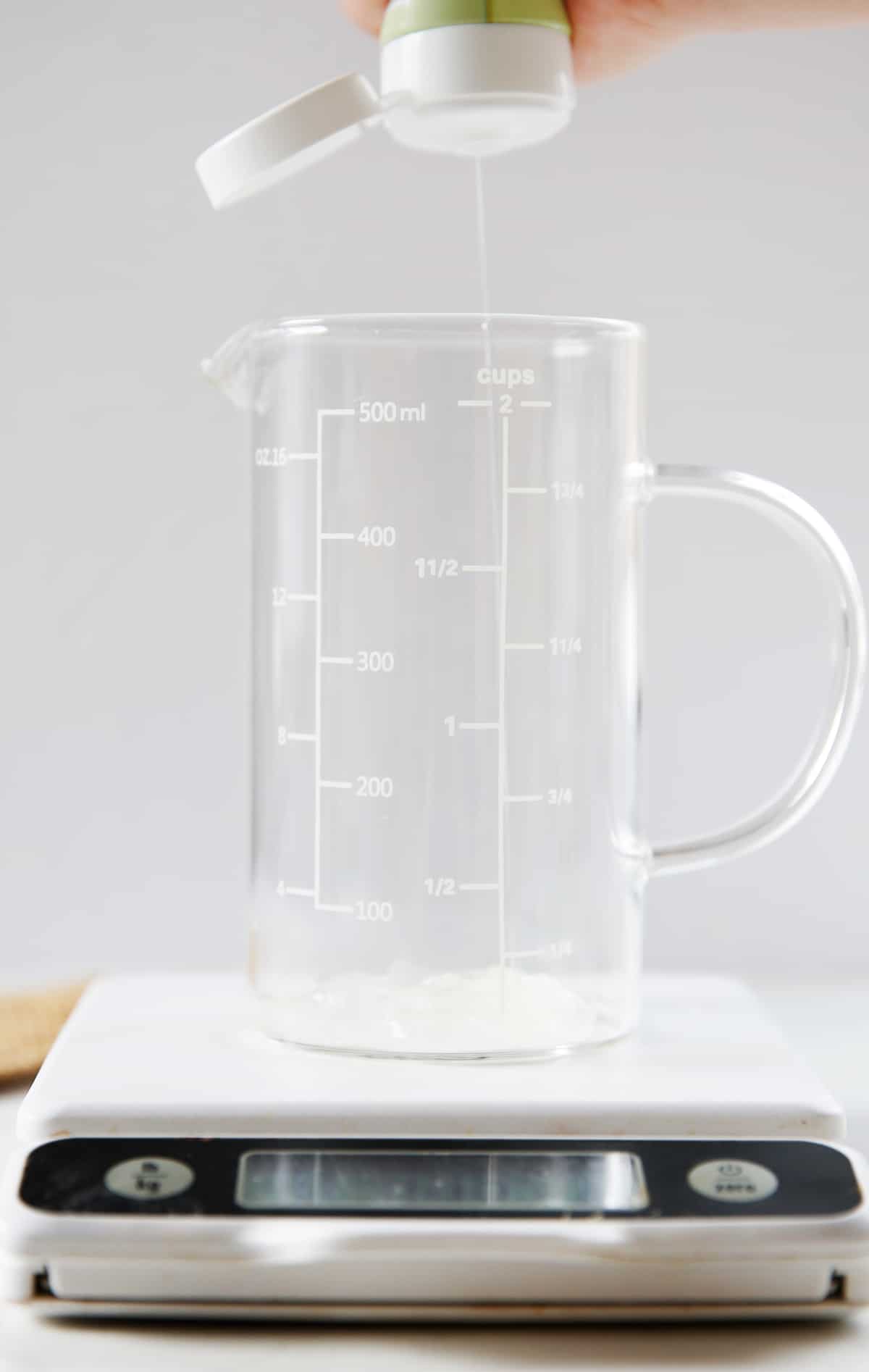
That being said, making your own DIY hand sanitizer is a simple process that only requires a few ingredients (although you can add a few others for extra benefits). And since many mainstream hand sanitizers contain dangerous fragrances and an antibiotic compound called triclosan that the FDA has raised concerns about, you’re probably better off making your own, anyway.
What You Need to Make it
- 99% rubbing alcohol (you can use 70% alcohol but you must change the proportions of the recipe, per the CDC). This is the active ingredient in any hand sanitizer recipe, and it needs to comprise at least 60% of the product in order to be an effective disinfectant. Use specifically isopropyl alcohol (rubbing alcohol) or ethanol (grain alcohol), since others can be toxic.
- Aloe Vera Gel
- Essential Oils (like Tea Tree & Lemon)
- Vitamin E Oil (optional)
- Small Glass Bottles
- Squeeze Tubes
- Funnel (or just pour it in)
- Mixing bowl or Liquid Measuring Cup
- A non-metal utensil for mixing (we found the aloe stuck to a metal whisk)
The Process
- Start by sanitizing all of your tools (glass bottles/squeeze tubes, liquid measuring cup, and a spatula) in hot water or a dishwasher. There’s no point in making something that’s meant for sanitizing in an unsanitary way!
- Put the rubbing alcohol and aloe vera gel in the bowl and mix thoroughly with the spatula. (If you’d prefer, you can put the ingredients directly into a jar or the bottle and shake it.)
- Add your desired add-ins.
- Use the funnel to carefully pour the sanitizer into your bottle.
How it Differs from Store-Bought Hand Sanitizer
As we’ve been using the hand sanitizer over the last week we’ve noticed that the aloe vera doesn’t stay homogenized very well. To counteract this we shake up the bottle each time we’re going to use it. Keep in mind when you put this together that this DIY hand sanitizer has minimal ingredients, with the most important one being the alcohol. If your aloe does separate, this isn’t a concern, it merely means it isn’t blending well. Shake it to the best of your ability, but don’t sweat it, as long as you’ve got the alcohol you are good to go. We realize this isn’t a perfection solution and isn’t an exact replica of buying factory made hand sanitizer, but this has been so helpful for us since we cannot purchase it in the store, and we hope it will for you too.
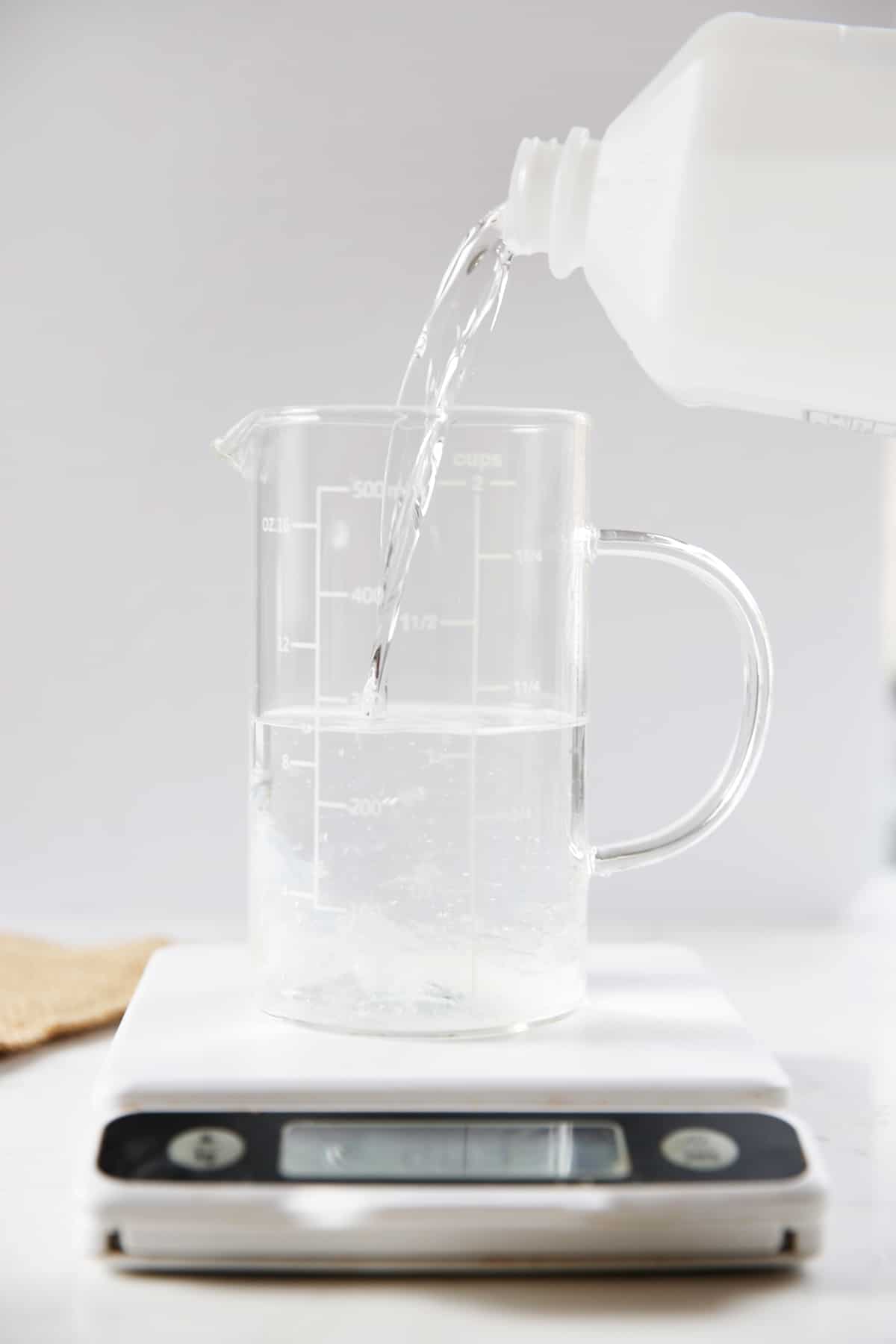
Additional Add-Ins
Here are some other optional ingredients you can add to make it nicer to use! However be careful of how many additional products you add-in as it could dilute the alcohol. Keep in mind you need at least 60% alcohol in the solution.
Essential Oils:Different essential oils can add different properties to your hand sanitizer. Oils like tea tree, thyme, and clove have antimicrobial, antibacterial properties to help the sanitizer work even harder. Add just one or two drops of those oils to your mixture.
Gentle essential oils like lavender or chamomile can have a soothing effect on your skin and can be used in a slightly larger quantity — three to five drops. For a natural fragrance, you can also add five drops of lemon or orange essential oil! Safe essential oils should be labeled as wildcrafted, organic, and extracted without solvents.
Vitamin E Oil: Mixing in five drops of vitamin E oil will make your hands a little softer!
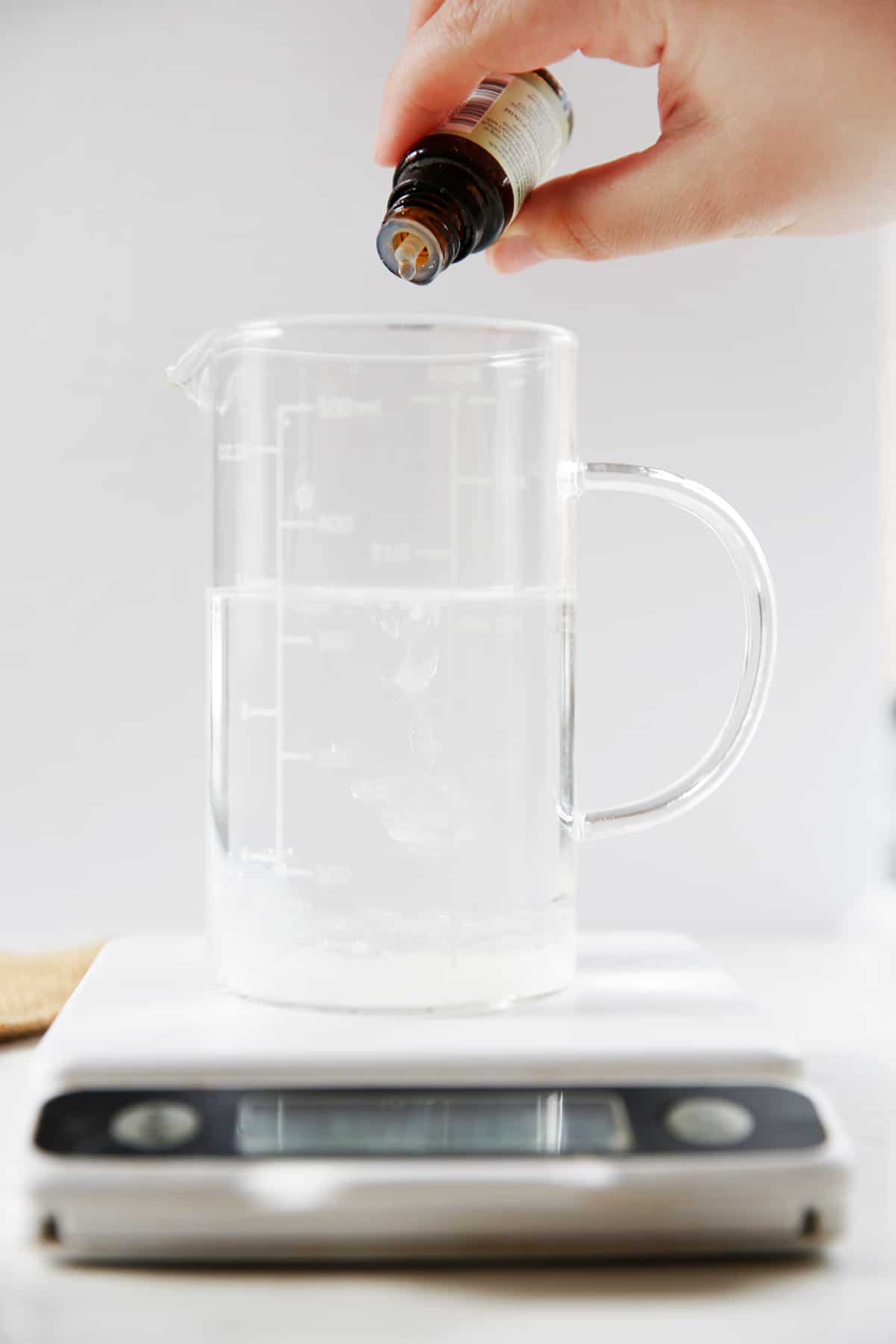
How long does it last?
Homemade hand sanitizer can be used effectively for up to twelve months, but don’t use it as a substitute for washing with soap and water! That should still be your family’s primary mode of washing up whenever possible. DIY hand sanitizer can also freeze and make a mess, so be sure to take it out of your car if temperatures are getting especially chilly.
Moisturize
Hand sanitizer, especially alcohol-based can be drying on your hands, so make sure to moisturize!
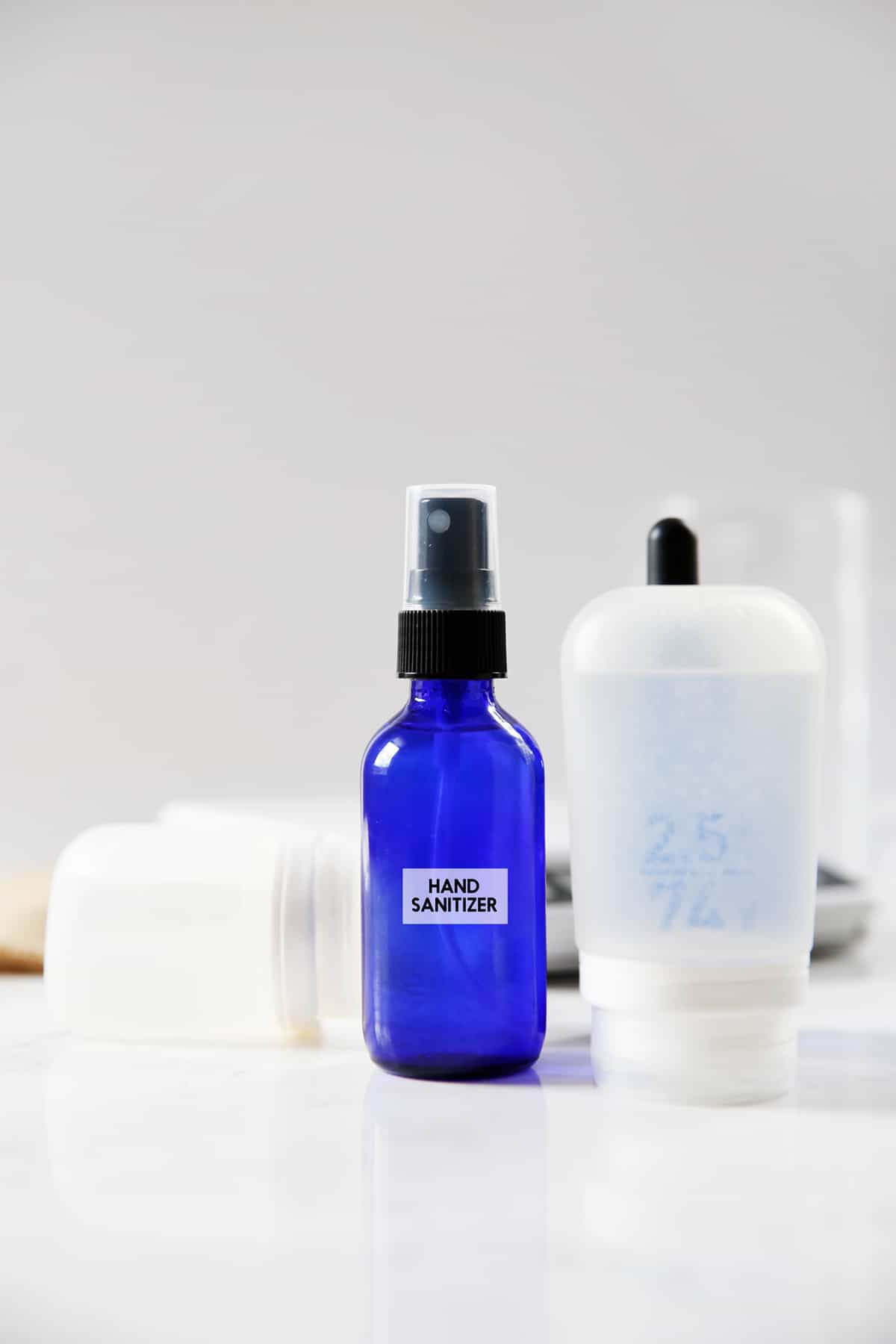
Wash up, everyone, and stay healthy!
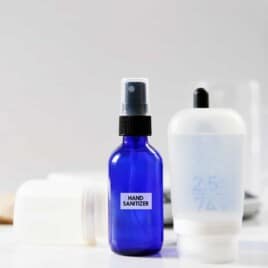
DIY HAND SANITIZER
Ingredients
- 6 tablespoons 99% isopropyl alcohol see note
- 2 tablespoons aloe vera gel
- 8-10 drops of essential oil optional
- 5 drops vitamin E oil
Instructions
- Sanitize all equipment that will come into contact with the sanitizer either by running it in a dishwasher or boiling for 5 minutes (take care to only boil heat safe items).
- Either mix together ingredients in a sanitized bowl with a non-metal utensil, or add the ingredients to your destined sanitizer container and mix it up.
Notes
- If you are using a 70% isopropyl alcohol you need to change the proportions to this:
- 7 tablespoons plus 1 teaspoon of 70% isopropyl alcohol
- 2 teaspoons aloe vera gel
DISCLAIMER: This website provides general information and discussions about health and related subjects. The information and other content provided in this website, or in any linked materials, are for informational purposes only and are not intended and should not be construed as medical advice, nor is the information a substitute for professional medical expertise or treatment. If you or any other person has a medical concern, you should consult with your health care provider or seek other professional medical treatment. Reliance on any information provided on this website or any linked websites is solely at your own risk.
Pin for later:
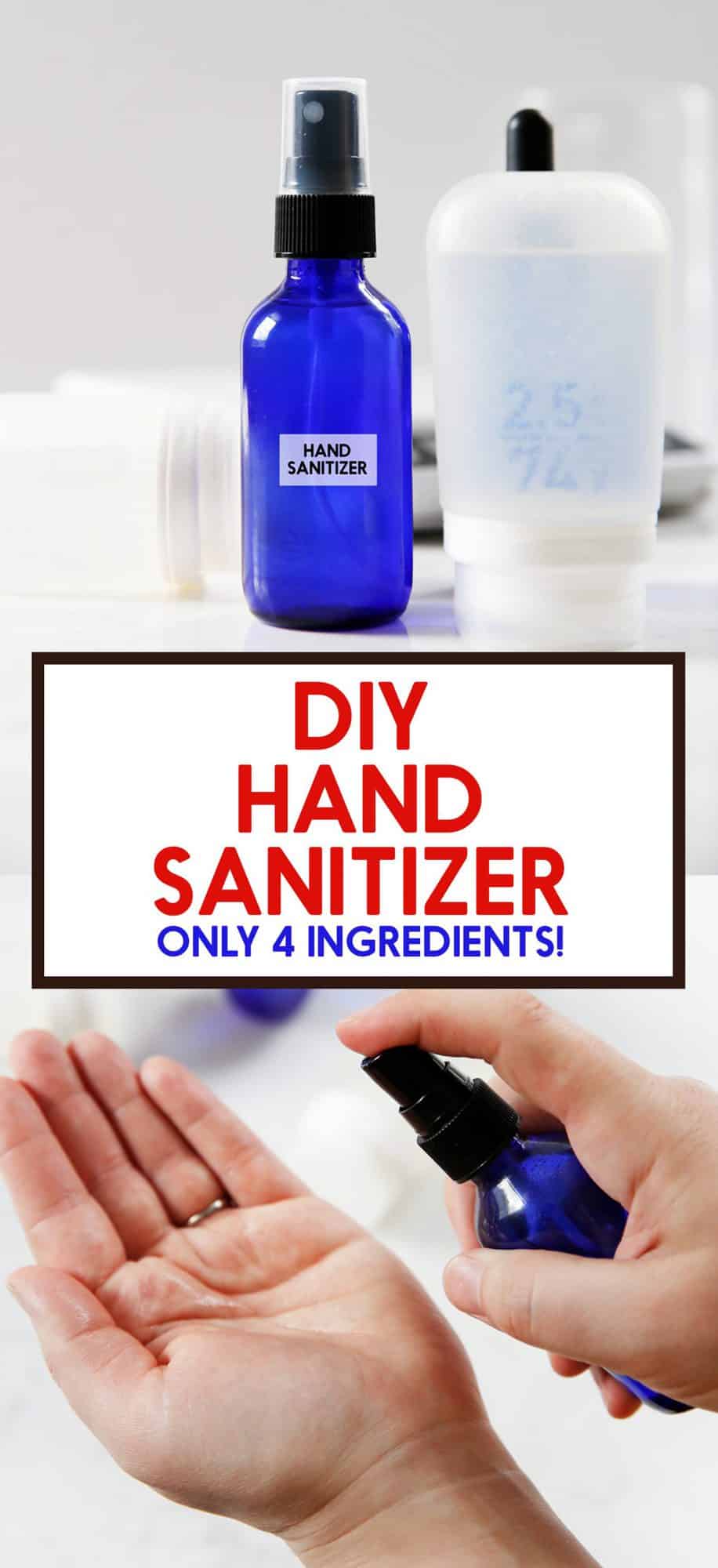
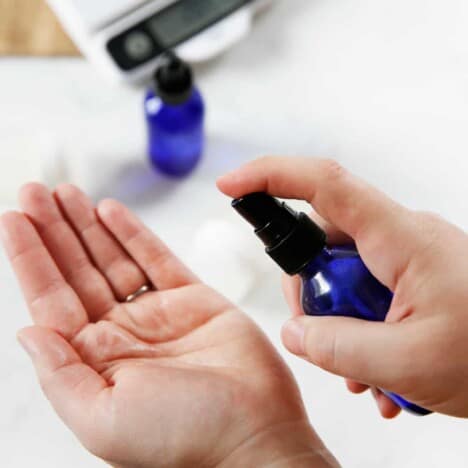

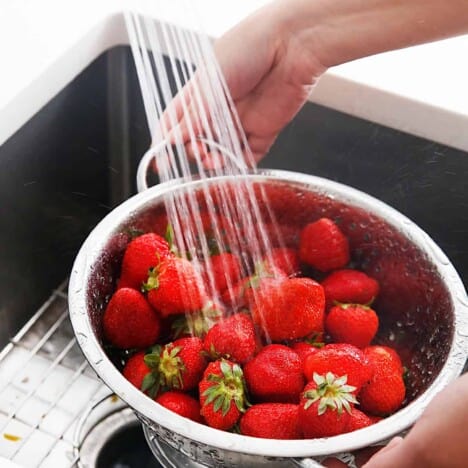



Thanks for sharing this recipe! Is the 95% alcohol okay to use too? The perfume grade one?
Yes
I’m talking about 151 proof grain alcohol.
Anyone else’s mixture get very, very warm (almost hot) after whisking it? I used 91% isopropyl and Lily of the Desert Aloe Gel. It’s kind of freaking me out.
Thanks so much for the instructions but I’m confused with the brand of vitamin e oil. Can you please recommend some specific ones?
I am unable to get Aloe Vera gel from the stores. Am I able to use fresh aloe vera (the plant) and if so, how much of each should I use with 91% isopropyl alcohol?
Thank you!
Hi Rosa! Unfortunately we wouldn’t recommend using the aloe from the plant. The aloe you purchase has been processed to make it safe to use long term, and we just can’t recommend using fresh from the plant aloe for this hand sanitizer. Ultimately the aloe is just to help curb the direct use of alcohol on your hands, so if you cannot get purchased aloe, try buying vitamin E oil instead. Also, we recommend calling local pharmacies to see when they will be getting their next shipment of aloe. We have found this to be the best approach to buying products that are in high demand, at this time.
Hi there,
Thank you for all of this info. I’m curious, What is the amount of aloe gel needed if you use 151 proof alcohol. For example if I use a half cup of 151 proof, how much aloe gel should I use, and how much Vitamin e oil do I need.
Thank you.
Are you talking about isopropyl alcohol?
Hi there, I have 99% Isopropyl alcohol, ForPro brand. I am not familiar with this brand and I am a little concerned about the warning label. “Danger: Extremely Flammable; Toxic” there is also a note on the bottle that says… Do not use for disinfecting implements or to be used as a substitution for hand sanitizers. I have never used isopropyl alcohol stronger than 70%. This may be just a normal warning, I am just unsure and was hoping for an educated opinion. Thank you, Kim
PER CDC, you want to use 99% rubbing alcohol (you can use 70% alcohol but you must change the proportions of the recipe, per the CDC). This is the active ingredient in any hand sanitizer recipe, and it needs to comprise at least 60% of the product in order to be an effective disinfectant. *Use specifically isopropyl alcohol (rubbing alcohol) or ethanol (grain alcohol), since others can be toxic.
Following Amy’s 95% grain alcohol question. I mean I could always just skip the gel base and just dowse my hands in Erverclear (hahahaha) but my boss may frown upon me bringing it to work. But all jokes aside I was kinda thinking based off both equations above 6.5 to 7 tbl to 2 tbl would still work best.
Can I use vit E instead of the Aloe Vera? I only have 70% running alcohol , vit e, tea tree oil and lavender oil
The aloe vera is to make it easier on hands, as using straight alcohol on hands can be irritating. However, it is the actual alcohol that does the disinfecting. Definitely add vitamin E to help keep hands from being too irritated.
What would the proportion of alcohol to gel be if you used Everclear which is 95% grain alcohol by volume. Grain alcohol is ethyl alcohol hitch I believe is an approved kind of alcohol with which to make hand sanitizer. Thanks.
PER CDC, you want to use 99% rubbing alcohol (you can use 70% alcohol but you must change the proportions of the recipe, per the CDC). This is the active ingredient in any hand sanitizer recipe, and it needs to comprise at least 60% of the product in order to be an effective disinfectant. *Use specifically isopropyl alcohol (rubbing alcohol) or ethanol (grain alcohol), since others can be toxic. Make sure if you’re not following it exactly you follow CDC recommendations to avoid toxic alcohols!!
I’m actually having the same issue as Mary and John. The aloe remains complete separate from the alcohol. I used Aubrey Organics Pure Aloe Vera Gel. I used the 70% alcohol recipe (because that’s what we were lucky enough to have in the house) so I figure we are just at a 70% ratio instead of 62%. We’re using it sparingly and moisturizing.
It definitely shouldn’t be completely separated, but read through the post, we updated to address this issue.
My aloe still sticks to the non wire whisk…and I have tried putting it in the bottle and shaking it but it still sticks to the dispenser tube.
Hi Mary! What type of dispenser are you using? And what brand of aloe? While we’ve noticed the aloe doesn’t always blend up completely with the alcohol since there are minimal ingredients, we haven’t noticed it sticking to a container.
I only have 50% rubbing alcohol and aloe vera gel what is the ratio if I’m using 151 proof grain alcohol to the jail?
Sorry I’m not sure about the second half of your question, but I just don’t think the 50% rubbing alcohol will work for this safely.
Hi. Thanks. I followed the recipie, except for the essential oils as I have none, but I saw other places this is mostly for the smell? Anyway, when I mix the 99% isopropyl with 98% aloe vera gel from a pharmacy I get lots of white goo in the mix. What gives?
Hi John, yes the essential oil is just for the smell. Why type of utensils did you use to mix, if any? The goo is just the aloe vera. Shake it up before you use it if it continues to coagulate. Remember, there are minimal ingredients and no products to keep it homogenized so this is natural.
Is it fine to use Johnson’s aloe & vitamin e oil gel in substitution of the regular aloe vera gel?
I am not super familiar with that product, but taking a quick look online my best guess would be that is ok. Just make sure not to exceed the recommended amount based off of what percentage of rubbing alcohol you are using.
I have a bottle of 91% isopropyl alcohol. What would be the proportions if using that alcohol? Thanks for any help.
Hi Linda! I would do a ratio of 7 parts alcohol to 3 parts aloe vera for that.
Should the amount of aloe gel used with the increased amount of 70% isopropyl alcohol be 2t or should it be 2T as in the first recipe? 2t is a very small amount of gel.
Hi Amy! The proportions listed in the notes of this recipe are correct! If you use 70% isopropyl than it needs to be 9 parts alcohol to 1 part aloe, and we err on the side of caution of adding a bit more alcohol than needed to account for any added ingredients like essential oils or vitamin E. This homemade version is not like the gel you buy in the store. I hope this is helpful!
Is there any substitute for aloe vera with the alcohol. Cannot find aloe vera in any stores.
The aloe vera is largely used to keep hands from truly drying out, since alcohol is quite drying to hands. Unfortunately we realize that finding both of these products are becoming harder and harder. We recommend calling your local pharmacies or Whole Foods and asking directly when they are getting their shipments in. We have found that they usually know the day that way you can go straight there when they say they will stock it.
Can you substitute Argan oil for the Vitamin E oil?
That should work! Just be careful about adding too much of any additions beyond the amounts we recommended so that the total alcohol content stays at 60% of the total solution.
I cannot thank you enough for including the directions with 70% alcohol.